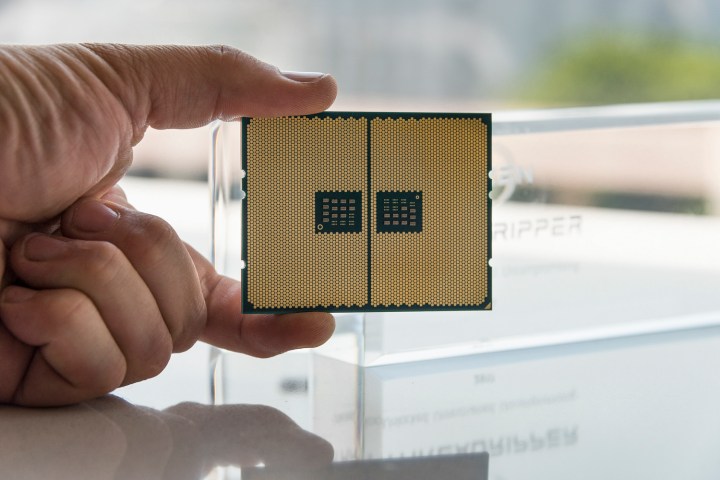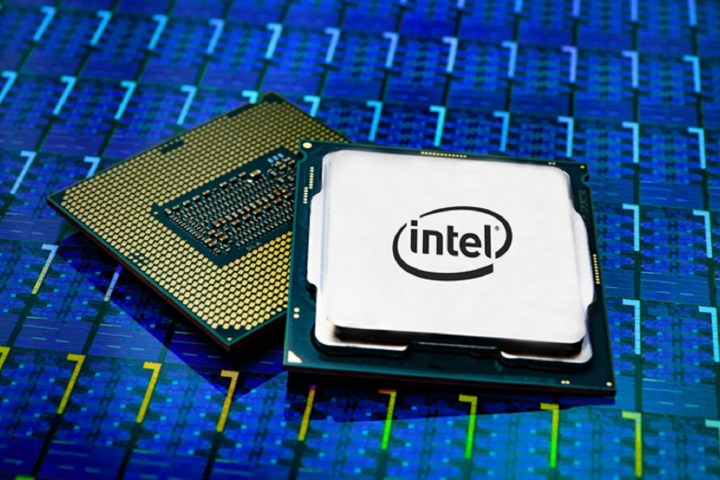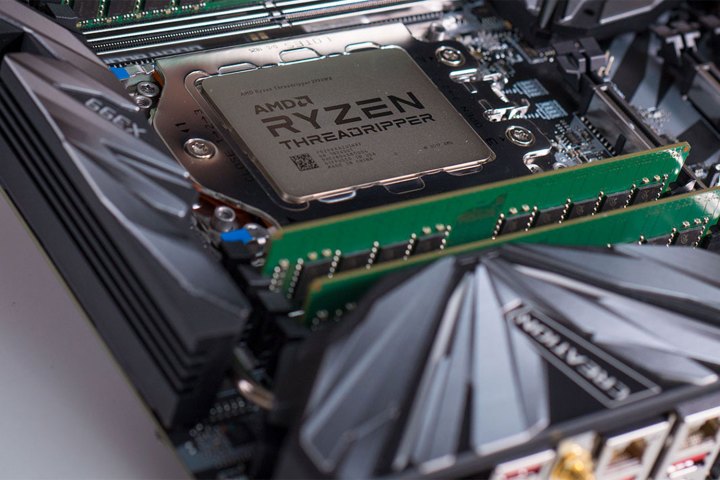AMD is assaulting Intel’s CPU market on all fronts in 2019. Its Ryzen 3000 mainstream processors provide serious competition across the board for Intel’s 9th-generation chips, and as we edge towards the close of the year, the high-end desktop (HEDT) wars have begun anew. AMD has launched its 3rd-generation Threadripper CPUs, while Intel has a new range of Cascade Lake-X chips to counter it.
But which will come out on top? In the Cascade Lake X vs. Threadripper 3000 battle for the best HEDT processors ever, which will take the top spot?
Pricing and availability

AMD launched its first Threadripper 3000 CPUs, the 3960X and 3970X on November 25, debuting them alongside the flagship mainstream Ryzen 3000 processor, the 3950X. These processors all have heaps of cores between them, but the 3960X and 3970X sport 24 and 32, respectively. Stock was swiftly bought up, so prices have risen in turn, but their official cost is $1,399, and $1,999 — be wary of spending much more than that while scalpers try to take advantage of the shortage.
A Threadripper 3990WX with 64 cores is expected to debut in early 2020, but AMD hasn’t released any concrete information about it, including pricing or release date. Considering the near-$2,000 price of the 3970X, we would expect it to be far north of that milestone.
In a real position reversal of previous generations, Intel’s HEDT CPUs are actually the cheaper ones this time around — and by quite a margin. The new lineup of 10th-generation Cascade Lake-X CPUs is four strong, refreshing its 10, 12, 14, and 18-core options, as the 10900X, 10920X, 10940x, and 10980XE, respectively. These chips have been aggressively priced at near half that of their predecessors, now costing just $599, $700, $797, and $1,000 a piece.
Intel’s range has a notable absence of eight core and 16 core chips, though with AMD’s strong position in the mainstream sector with those particular core counts, it’s perhaps understandable.
Performance

AMD’s Threadripper 3000 CPUs are based on the same Zen 2 architecture as the Ryzen 3000 mainstream chips. They combine a 12nm I/O die with a number of eight-core, 7nm chiplets. There have been three models confirmed so far, with 24, 32, and 64 cores each. All of them enjoy a near-15% uplift in instructions per clock and improvements to memory efficiency over second-generation Threadripper CPUs.
| Cores | Base clock | Boost clock (single core) | L3 Cache | PCIe Lanes | TDP | |
| AMD Ryzen Threadripper 3960X | 24 | 3.8GHz | 4.5GHz | 128MB | 64 | 280w |
| AMD Ryzen Threadripper 3970X | 32 | 3.7GHz | 4.5GHz | 128MB | 64 | 280w |
The 3960X and 3970X have nearly identical specifications, other than their core counts. They have base clocks of 3.8GHz and 3.7GHz, respectively — that’s an 800 and 700MHz improvement over their second-generation counterparts. They’ll also boost up to 4.5GHz on single cores and enjoy as much as 128MB of L3 cache.
| Cores | Base clock | Boost clock (single core) | L3 Cache | PCIe Lanes | TDP | |
| Intel Core i9-109020X | 10 | 3.7GHz | 4.7GHz | 19.25MB | 48 | 165w |
| Intel Core i9-10920X | 12 | 3.5GHz | 4.8GHz | 19.25MB | 48 | 165w |
| Intel Core i9-10940X | 14 | 3.3GHz | 4.8GHz | 19.25MB | 48 | 165w |
| Intel Core i9-10980XE | 18 | 3.0GHz | 4.8GHz | 24.75MB | 48 | 165w |
Intel’s Cascade Lake X is much more of an evolution, than a revolution. It’s based on an enhanced version of the same 14nm process node as the previous two-generations of Intel HEDT chips and features minor improvements to IPC and a slightly higher clock speed. That is only for single-threaded applications though, with the all-core boost identical to that of the last-generation.
The most notable difference between the two ranges of chips are the core counts and L3 cache numbers. They give AMD an enormous advantage when it comes to multithreaded performance, both on paper and in the real world.
Reviews of both new CPU lines show the AMD chips as far more capable than the Intel counterparts, with many applications showing a near 100% performance increase from the 18-core Intel 10980XE, to the 32-core Threadripper 3970X. The disparity wasn’t always quite as stark, but in almost every productivity test, from video encoding, to rendering and 3D modeling, the Threadripper CPUs completely outclassed the Intel alternative.
Arguably just as impressive however, is that AMD’s Threadripper chips are comparatively capable in lower thread count tasks as well. That has typically been Intel’s domain to dominate, but now Threadripper 3000 is as good, if not better than Intel’s best in even the odd game. That’s not something these chips are really designed for, but it shows that AMD’s processors are now great all-rounders, as well as being amazing for multi-threaded workloads.
It’s worth noting that the AMD chips do have a much higher TDP than Intel’s, and they are hot chips that need decent cooling, especially if you’re thinking of overclocking them. But Intel’s chips get hot and demanding too when under heavy load. Efficiency is important, but less so in HEDT designs where raw power is paramount.
PCIe lanes also lean in AMD’s favor, potentially opening up the use of a greater number of add-in cards and storage drives than Intel’s alternative, especially since Threadripper supports PCIe 4.0.
Sockets
One downside to the new generation of AMD Threadripper CPUs, is that they use a new TRX4 socket. That’s different to the TR4 socket used on first and second-generation Ryzen Threadripper motherboards and brings an end to AMD’s plan for inter-generational compatibility with that line of Ryzen chips. It means that anyone looking to upgrade will need a new motherboard too, which adds considerably to the overall cost.
Intel’s new chips, on the other hand, use the same LGA_2066 socket as their predecessors, meaning that even users of the seventh generation Skylake-X HEDT chips will be able to upgrade to the new Cascade Lake options without having to change their motherboard. The performance difference between those two ranges is far narrower than AMD’s though.
AMD dominates in decisive fashion
AMD won big with the launch of Ryzen 3000 mainstream processors, and it’s done so in even more emphatic fashion with Threadripper 3000 CPUs. With a combination of stellar performance in both single and multi-threaded scenarios, these new chips are strong where Intel is typically strongest, and stronger still where AMD typically holds its own.
With more cores, more threads, competitive clock speeds and IPC, AMD’s new chips are just leaps and bounds ahead of the competition. With Intel simply offering up slightly boosted 14nm chips in the form of Cascade Lake X, it just can’t keep up.

Intel is aware of this and has aggressively priced its new generation in order to counter AMD’s new performance dominance, but will it be enough? For those with existing Intel systems, the upgrade isn’t worth much, even at the more affordable level, and there’s no denying that 64 cores of Threadripper CPU may just be too attractive an option over the 18-core alternative with Intel.
But where a $1,000 difference even between existing 18-core Intel and 32-core AMD processors might seem a lot, when you’re a professional or company making money with this hardware, the cost is negligible. Threadripper 3000 CPUs offer a massive increase in performance over their last generation and Intel’s best, shaving real minutes and seconds off of compute loads. That can translate to real money earned and savings made. It even starts to challenge what AMD and Intel’s server CPUs can do, and those are thousands more expensive again.
This is really bad news for Intel and shows a true changing of the guard when it comes to HEDT leadership. It could be years before Intel fully recovers from this. For now, AMD is top of the pile.
Editors' Recommendations
- It just became the perfect time to buy a last-gen Intel CPU
- AMD is making the CPU more and more obsolete in gaming
- Nice try, Intel, but AMD 3D V-Cache chips still win
- AMD vs. Intel: the rivalry has never been more fierce
- The best cooler for the 7800X3D isn’t as powerful as you’d think





